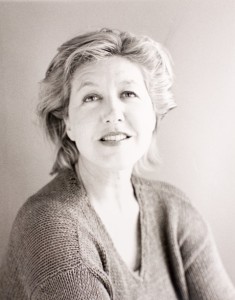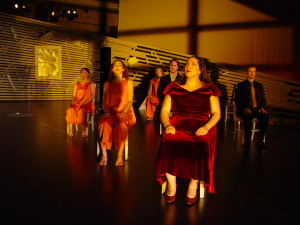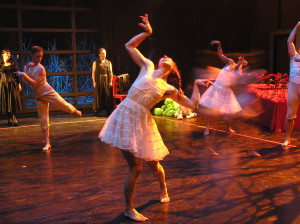
It’s been almost one year since Bay Area dance luminary, Della Davidson, died of cancer. She was a quiet and introspective person, but she made bold and dynamic works of visually stunning dance-theatre. Her work was powerful and challenging because she relished in a performance space where multiple artistic visions, aesthetics and ideas could exist together—sometimes crashing into one another and sometimes playing with each other. As her husband Mark Reiff recently told me, “Della never minded mess because creativity emerges from mess.” Della could take what should be messy, incoherent and discordant and make rich, layered and complex dance landscapes.
When someone like Della dies, someone who has elevated a field, who has created and supported a community of artists, who has been a mentor and inspiration to so many people, we naturally talk about legacy. But what does legacy actually mean? Are we building something or preserving something? Neither action seems quite right when it comes to Della. She wouldn’t want a fixed thing to be constructed or manufactured in her honor. I don’t think she would want her legacy to really be about her. She was not an egotistical person. While legacy is about memory, it has to be more than the preservation of snapshots and sound bites. While I will always remember Della’s work filled with colorful dreamscapes full of gestural symbolism, her unique artistic vision can’t be duplicated or imitated. Della loved the ephemeral nature of dance, and would want her legacy to be like her choreography and her creative work ethic: honoring the past by dancing and innovating in the present.
Della’s legacy is about carrying forward the values that her artistry embodied in the dance communities that she lived in and loved. Values like collaboration, equity, diversity, commitment to craft and a uniqueness of vision. Very practically, Della’s legacy is about providing much-needed resources to dance artists who embody these values and helping those artists to bring their visions to fruition. As Della’s work always included multiple symbiotic but separate theatrical elements happening at the same time, it is fitting that the current work of her legacy includes three distinct but related entities working alongside one another.
Two different funds have been established to support dedicated artists in the dance communities that Della contributed so much of herself to: the Della Davidson Memorial Fund at UC Davis and the Della Davidson Prize, administered through Dancers’ Group in San Francisco. A digital archive project is also currently underway at UC Davis to inspire dance-makers and researchers in the future.

The Della Davidson Memorial Fund
The Della Davidson Memorial Fund was established at UC Davis to support mid-career dance makers seeking an entré into the university environment. Della taught at UC Davis for over 10 years. She had a unique vision for the choreography strand of the MFA program in Dramatic Art. She specifically worked with mid-career choreographers, those who had already established a strong creative vision and a body of work, and were looking to strengthen their university experience. Della was a guide, facilitator and an advocate for her MFA students. She created an environment where choreographers could gain the necessary university experience while also elevating their own craft at the same time. She treated her students as equals, as the fellow artists that they were. She gave them time and space to work and also helped them navigate the unfamiliar university world. Dance artists like Kim Epifano, Keith Hennessy, Randee Paufve and Eric Kupers came through the MFA program. All of them have very distinct artistic visions. The connection between all of them is an exploration of inclusion in their choreography: inclusion of all ages, of different body types, of multiple abilities. When they create, they are carrying Della’s legacy forward because she too worked inclusively, representing diversity of thought, of appearance, of dance styles in her work.
Ironically, the MFA program in Dramatic Art at UC Davis is repositioning itself to no longer specifically include choreography. The very last MFA students in choreography, Christine Germain and Jarrell lu-Hui Chua are graduating this spring. These artists are graduating from the program that Della built without Della’s guidance. Since Della is irreplaceable, perhaps this new vision for the MFA program is a good thing. The new focus will allow for a larger pool of artistic visions and interdisciplinary collaborators to work together, but it also signifies the end of Della’s era at UC Davis.
That is why the establishment of the Della Davidson Memorial Fund is so important. It ensures that dance-making and dance-makers will always be included in this new interdisciplinary focus. Interdisciplinarity was a hallmark of Della’s work. She never paid much attention to the distinctions between dance, theatre, visual art and performance art, preferring to mix them altogether in a big, performance pot. However, she did consider herself a choreographer first and she was very aware of the particular needs of artists working in movement forms. Dance was her lineage and dance-makers were her community. What is currently missing in the program and what I also hope the Della Davidson Memorial Fund will be an advocacy tool for, is a leadership and mentorship presence focused on dance and choreography within this interdisciplinary MFA program.
The Della Davidson Prize
During Bay Area Dance Week, the first two recipients of the Della Davidson Prize will be celebrated. While the Memorial Fund at UC Davis is subsumed under the mammoth and opaque UC funding system, the Della Davidson Prize is very straightforward: it’s a cash prize given to a regional dance artist who embodies Della’s values. The prize was established by a small committee of dance artists who worked closely with Della and her husband Mark Reiff. The founding committee developed a framework for artist selection and a detailed set of criteria directly related to Della’s values including multi-disicplinarity, collaborative process, the empowerment of women and diversity among others.
This inaugural year, two very different choreographers are receiving the prize, Randee Paufve and Monique Jenkinson. $1,220 will be given this year to each artist, a sentimental number representing Della birthday on December 20th. It is a rare thing for a cash prize to be given to an individual artist without strings attached. The money is always nice, but this prize is also a show of faith in the integrity of individual dance artists. When I asked Randee Paufve what this prize means to her, she said, “this is support for the form, for the power of the form and the mystery of choreography.” The fact that this award is unfettered by an application or grant report is representative of that trust in mysterious process. Allowing for the mystery, for the unknown, is what Della always did so well because she trusted artists. She had faith in an artistic process that allows for the work to reveal itself. This prize is not a lot of money, but it is a significant gesture, letting the artists’ work stand for itself, without the burden of wordsmithing an artist statement and project description.
Monique Jenkinson isn’t from the same dance-theatre lineage as Della, and yet her work exemplifies Della’s values, particularly a focus on the complexities of womanhood. Jenkinson said, “Della made great dance for women to do. Our connection is once removed, but it’s meaningful to be chosen in her spirit and to uphold who she was as an artist and a woman.” This prize is not limited to those who were in Della’s world. In fact, it is meant to extend Della’s legacy beyond those who knew her. According to committee member Kegan Marling, Monique and Della “have not intersected at all and yet, Monique’s work has many characteristics that were highlights of Della’s.” Through her drag alter-ego Fauxnique, Jenkinson theatricalizes the feminized body. Her most recent work, Instrument explored the body as both instrument and object. While the character Fauxnique is campy and over the top, the work is deep, well researched and intellectually challenging. Jenkinson’s seamless melding of drag, camp, ballet, post-modernism and monologue pushes the descriptive boundaries of dance and is indicative of the type of inter-discplinarity that would excite Della.
For this inaugural year, it feels fitting that two choreographers receive the Della Davidson Prize. Unlike Jenkinson, Randee Paufve was very much in Della’s world. While Della was always interested in pushing the form of dance, she also continually supported her own community. She was fiercely loyal. Paufve was a student of Della’s and has danced with Della’s Side Show Physical Theatre. Her work feels aesthetically like it exists in the same dance-theatre lineage as Della’s. Paufve has a similar cerebral quality accompanying her very deep, continually evolving kinesthetic craft. Like much of Della’s work, Paufve’s recent dances are expansive, with a diverse ensemble and intricate theatrical design elements to create an immersive dance world. This is a very personal honor for Paufve. She said, “I got to be a part of her (Della’s) work. I carry an ember if not a torch forward for her and for her work.”

The Della Davidson Archives
While providing financial resources may be the most immediate way to carry forth Della’s desire to support the field of dance, there is another extremely important resource currently in development. Mark Reiff is working on establishing the Della Davidson Archives available through a searchable website hosted at UC Davis. Della had massive amounts of rehearsal and workshop footage. Reiff is digitizing all of it in the hopes that it will provide a glimpse inside a creative process. It is not meant for the recreation of Della’s works or even necessarily about preservation. It is about inspiration: providing an example to those who might have the creative urge and need a starting point. Reiff is developing a second audio track for the archives in which audiences will hear Della’s collaborators talk through the process of what is happening on the videos. This will be a multi-faceted website to explore how a creative process works and how one might use the tools of dance to create.
The Future of Della’s Legacy
Della often drew out hidden talents in her students. For Paufve, it was writing. For me, it was a new approach to teaching. The Della Davidson Archive is meant to inspire in that way, using intimate, messy, unfinished rehearsal video as a source of personal discovery. This website could be a new way that the tendrils of Della’s legacy will grow and reach into the future, drawing dancers and researchers to look differently at creative process in the university that Della called her academic home. Reiff is hoping to have the archive up by the announcement of next year’s winners of the Della Davidson Prize and there is enough cash in the coffers of the two funds for approximately five years of support. Hopefully as artists benefit from these awards, money will be raised for the their continuation. They are symbolic gestures of belief in the type of intellectually and physically rigorous, collaborative, risky, messy artistic process that Della embodied. The desire is that these funds and this archive will continue to carry the ember of Della’s legacy into the future, passing it to those who may have never known her, but still dance along the path that she forged.
For information and to learn how to support
The Della Davidson Memorial Fund: theatredance.ucdavis.edu/aboutus/giving.aspx
For information and to learn how to support
The Della Davidson Prize: dancersgroup.org
This article appeared in the April 2013 issue of In Dance.

